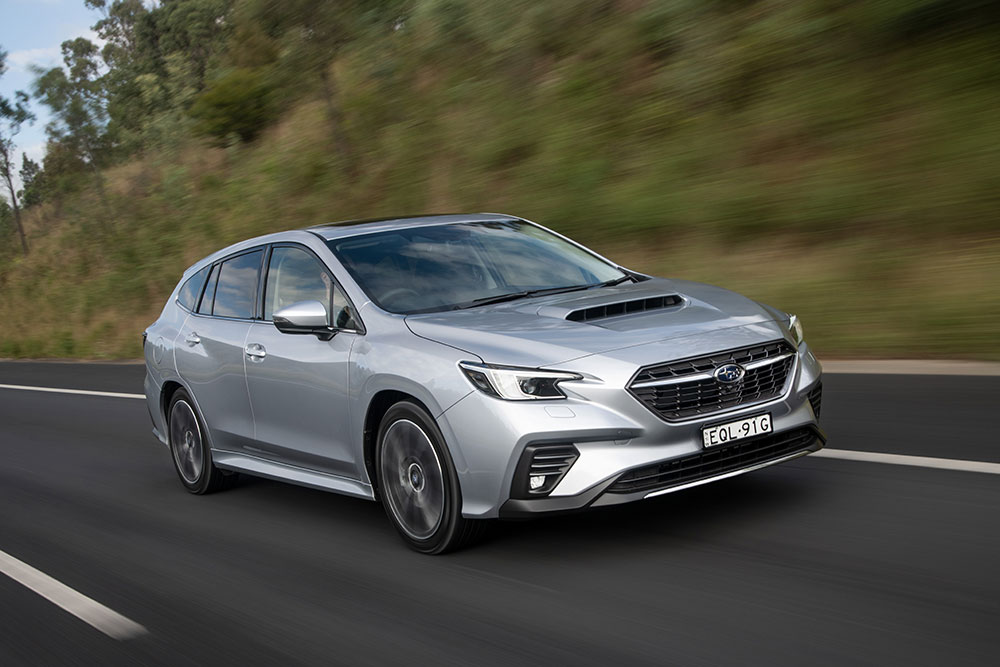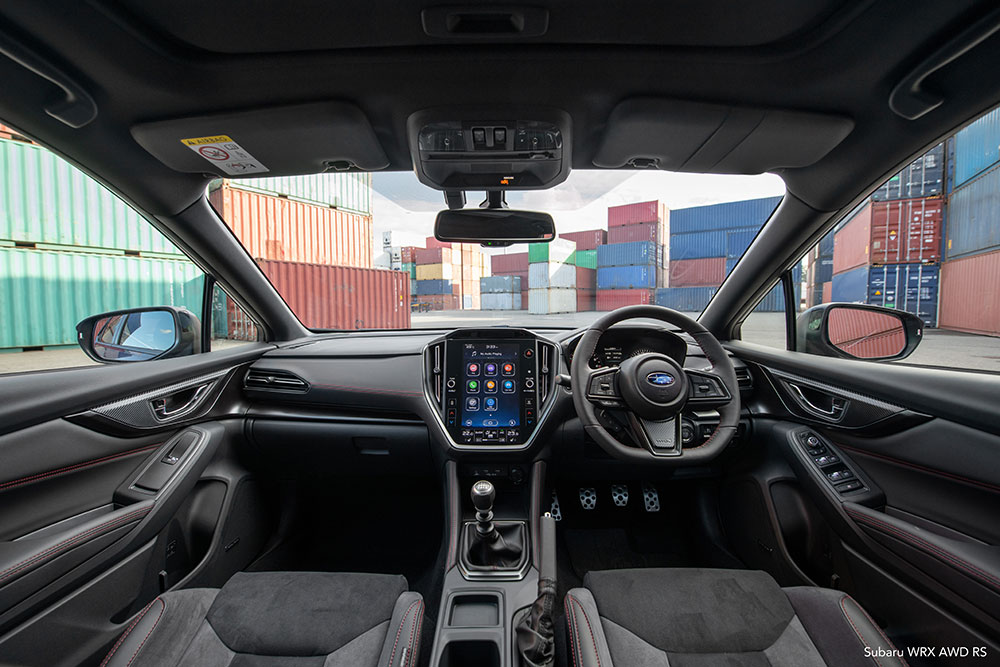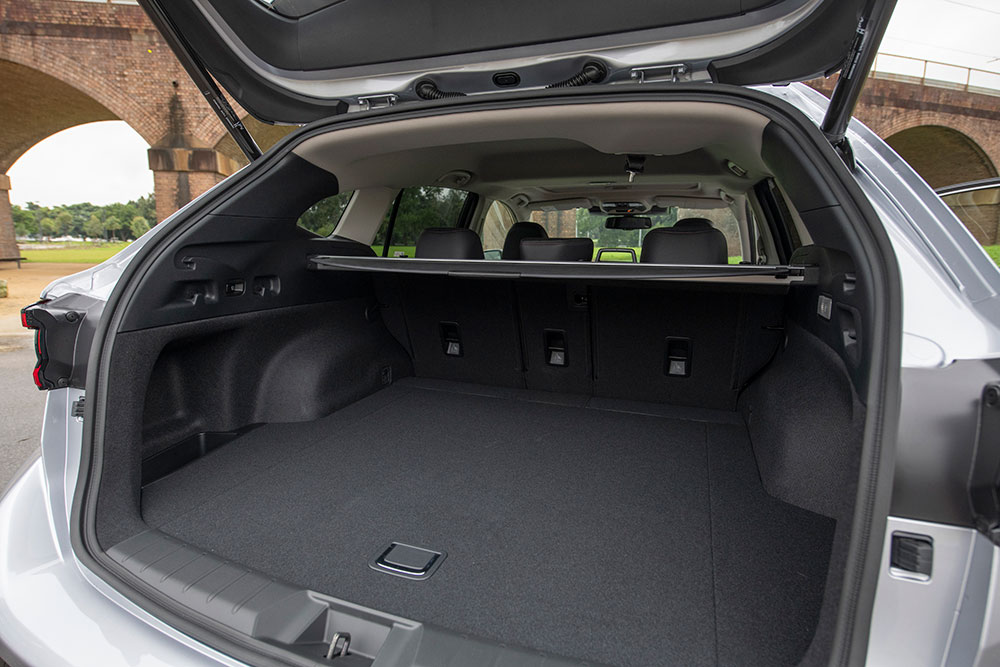Subaru’s WRX giant killer returns
Subaru has launched the latest iteration of its barnstorming turbocharged, all-wheel drive WRX performance car.

It’s hard to believe the Subaru WRX has been with us for almost 30 years, with the original launched in Australia way back in 1994.
Through successive generations, the WRX has gone from a raw, rally-bred enfant terrible to a more sophisticated and mature machine, as evidenced by the recently launched fifth-generation model.
The all-new WRX comes in sedan and sport-wagon body styles with turbocharged boxer four-cylinder engine and all-wheel drive as standard across a three-tier model grade in each body style.
Pricing starts at $44,990 for the entry-level WRX AWD sedan with six-speed manual, or $48,990 for the WRX AWD Sport with self-shifting Lineartrontic (CVT).
Stepping up to the WRX RS AWD sedan stretches prices to $50,490 for the manual and $54,490 for the RS AWD Sport Lineartrontic respectively, while the top-spec auto-only WRX tS Sport Lineartrontic sedan costs $56,990.
Choices are easier in the Sportswagon range as there’s no manual transmission available, meaning a Sportswagon AWD Sport will set you back $49,990, while the Sportswagon AWD GT Sport asks $55,490, and the top-spec AWD tS Sport costs $57,990.
Standard equipment across both body styles includes a new 11.6-inch central information display, tyre pressure monitoring system (TPMS), climate-control airconditioning, 18-inch alloy wheels, self-levelling and steering-responsive full LED headlights, plus LED front fog lights.
This new model doesn’t look dramatically different to its predecessor, but the sedan looks more muscular than the Sportswagon, thanks to its distinctive flared guards and dark side garnishes on sills and wheel arches.
Other performance-inspired design influences include air outlets on the trailing edges of the front wheel openings and a lip-style boot spoiler.
Without the side garnishes the Sportswagon is less aggressive looking and sits up a bit taller, with more ground clearance and a higher ride height than sedan.
It’s also longer and has a larger boot and rides on narrower 225/40R18 Yokohama tyres versus the sedan’s 245/40 R18 Dunlop SP Sport Maxx rubber.

Subaru said it was targeting different demographics with the two body styles and expected the sedan to have a heavier male skew, while the Sportswagon would attract a broader mix, including families.
This is also apparent in the way the two drive, with the Sportswagon softer and more compliant than the sedan, despite both riding on standard 18-inch alloys and having the same MacPherson strut front and double wishbone rear suspension.
Both body styles are underpinned by a new Subaru global platform which is claimed to be 28% stiffer than its predecessor, with associated ride and handling benefits.
Other changes include optimised chassis geometry with longer suspension stroke for improved grip and better ride comfort and a new dual-pinion electric power steering system, designed to deliver better response and feel.
Some models equipped with the Lineartrontic CVT also benefit from electronically controlled dampers, which enhance handling while refining ride quality.
But the big news for most WRX fans will be the fact that under the bonnet of all models is a larger displacement 2.4-litre turbo four-cylinder engine, replacing the previous turbo 2.0-litre unit.
The increase in capacity delivers more linear response compared with the old ‘freight-train’ arrival of maximum torque from some of the previous models.
Peak power of 202kW is a modest 5kW increase over the previous WRX and the 350Nm of torque is identical, but the extra cubic capacity means the engine is less stressed, and has a broader and more usable torque curve that ensures better low rpm driveability and more immediate response.
In terms of outright performance, Subaru was initially reluctant to table a 0-100km/h time for the new model, saying instead that its engineers were more focused on the way the new car came together in totality.
Nevertheless, after some badgering from assembled journalists, company representatives offered up an indicative 0-100km/h time of 6.0 seconds for the manual and 6.1 for the auto, which compares favourably with the former models’ 6.3 seconds.

Enthusiasts will likely choose the sedan, matched with the six-speed close radio gearbox, which is clearly the most performance-focused model.
However, the more widely available Lineartronic CVT, aka ‘Subaru Performance Transmission,’ is the better all-proposition for those using their WRX as a daily driver.
There’s also a compelling case to make for the CVT variants from a safety perspective, because only these vehicles get Subaru’s Eyesight safety technology as standard.
That’s a shame for manual enthusiasts because the latest generation of Eyesight is the best yet, boasting improved processing speed and revised camera hardware.
Other than this, all WRX models get eight airbags as standard, including a front passenger seat cushion airbag, with other standard safety equipment including blind spot monitor, lane change assist and rear cross traffic alert.
The newly developed Lineartronic auto is undoubtedly the company’s best CVT yet, delivering faster upshifts and downshifts compared to the outgoing model.
The transmission also features adaptive shift control, auto downshift blip when braking, and virtual eight-speed step-shift control when in sport mode.
The CVT-equipped models also come standard with Subaru Intelligent Drive system, or SI-DRIVE, which allows drivers to choose between three pre-set drive modes that alter engine and transmission characteristics.
These include Intelligent (I), for relaxed driving, Sports (S), for sharper throttle response and quicker shifts, and Sports Sharp (S#), for the keenest throttle response and fastest upshifts.
For those wanting that bit more control, tS trim variants of the sedan and Sportswagon offer a Drive Mode Select feature that allows the driver to further sharpen the car’s driving dynamics, by configuring the steering feel and the electronically controlled damper settings.

These variants also get a two-mode centre diff setting (Standard and Sport) which in Sport mode makes the centre diff more RWD biased.
Vehicles with the CVT get a Variable Torque Distribution (VTD) AWD system that typically distributes torque 45:55 front to rear but can electronically alter the torque split to enhance handling.
WRX variants with the manual transmission utilise a fully mechanical AWD system with a viscous-coupled limited-slip centre differential.
Whichever setup you choose, it all adds up to remarkable grip levels and impressive cornering ability.
Out on the road the smoother and more muscular delivery of the larger engine shows the WRX to be a much more driveable machine, while the improved handling and stronger body shell are appreciated over more ragged sections.
Whether rowing the more focused manual sedan through bends or taking it a little easier in the softer but still quick Sportswagons, the combination of all-wheel drive traction and muscular mid-range turbo thrust highlights the WRX’s impressive speed and grip.
It’s not just the powertrain that’s improved either, with the new model showing more polish across the board.
From its ride to its steering, to the more upmarket and comfortable interior and superior NVH, the WRX is now the sort of performance car a grow-up can aspire to.
Inside, shoulder room has been expanded both front and rear, and there’s more rear seat legroom thanks to a longer wheelbase.
Entry-level variants feature sporty grey or black cloth upholstery, mid-spec grades boast leather accents, while the top models featuring a more premium Ultrasuede.
Newly designed sports bucket seats offer comfortably snug seating, with extra side bolstering and a good range of adjustment, while splashes of red stitching and a sports steering wheel emphasise the car’s sporting credentials.

The new cockpit design features large and easily read instruments, with prominent speedo and tacho either side of a 4.2-inch multi-information display.
An 11.6-inch high-definition touchscreen provides Apple CarPlay, Android Auto, DAB+ digital radio and Bluetooth connectivity.
WRX AWD RS and WRX AWD tS Sedan variants also feature a premium Harman Kardon 10-speaker audio system with subwoofer in the rear parcel shelf.
Unlike past WRX generations, this model will not offer a high performance STI variant, but there is a range of STI accessories available, including body enhancements, an 18-inch alloy wheel, and uprated suspension components.
In summary, the Subaru WRX maintains all the speed and capability of its predecessors and is every bit as exhilarating to drive, but is a more refined and sophisticated proposition overall.
Critics may argue that the softer Sportswagons lack the hard performance edge of the manual sedans, and are therefore not true to the WRX ethos, but the combination of the auto gearbox and Sportswagon body style has effectively created a different vehicle within the range, which significantly broadens the car’s appeal.
*At the time of writing Subaru said the wait time from order to delivery was between two and three months.
Key stats
MRLP: From $44,990 (sedan) and from $49,990 (Sportswagon auto).
ENGINE: Horizontally opposed, 2.4-litre petrol 4 cylinder, turbocharged.
ANCAP CRASH RATING: Not yet rated.
FUEL CONSUMPTION (combined cycle, litres/100km): Manual 9.9 (225g/km), Auto 8.5 (192g/km CO₂).
FOR: Robust performance and improved driveability of larger capacity engine, terrific grip and cornering ability, impressive sports oriented CVT transmission.
AGAINST: Omission of Eyesight safety technology on manual versions, fuel consumption, Sportswagon less focused than the WRX badge suggests, temporary spare wheel.
Related topics
Things to note
The information in this article has been prepared for general information purposes only and is not intended as legal advice or specific advice to any particular person. Any advice contained in the document is general advice, not intended as legal advice or professional advice and does not take into account any person’s particular circumstances. Before acting on anything based on this advice you should consider its appropriateness to you, having regard to your objectives and needs.
Insurance Products (excluding Travel Insurance) are issued by RACQ Insurance Limited ABN 50 009 704 152 (RACQI) and arranged by its agent, RACQ Distribution Services Pty Ltd (RDS) ABN 35 116 361 650, AFSL 567130 and RDS' authorised representatives (including RACQ Operations Pty Ltd ABN 80 009 663 414, AR No. 234978 (RACQO). Conditions, limits and exclusions apply. RDS and RACQO are in the RACQ group of companies. One of the companies in the RACQ group of companies has a minority shareholding in RACQI.
RDS and RACQO have not taken your personal objectives, circumstances or needs into account when preparing advice regarding insurance products and you will need to consider whether the advice is appropriate for you. Read the Product Disclosure Statement (PDS) and any applicable Supplementary PDS before making a purchase decision on this product. You can also access our Target Market Determinations on this website. RDS receives a commission from RACQI for the policies it arranges. RACQO receives fees paid for services it provides to RDS. Further details about remuneration are available on request prior to purchasing.
Banking and loan products issued by Members Banking Group Limited ABN 83 087 651 054 AFSL/Australian credit licence 241195 trading as RACQ Bank. Terms, conditions, fees, charges and lending policies apply. This is general advice only and may not be right for you. This information does not take your personal objectives, circumstances or needs into account. Read the disclosure documents for your selected product or service, including the Financial Services Guide and the Terms and Conditions, and consider if appropriate for you before deciding.
Except for RACQ Bank, any RACQ entity referred to on this page is not an authorised deposit-taking institution for the purposes of the Banking Act 1959 (Cth). That entity’s obligations do not represent deposits or other liabilities of RACQ Bank. RACQ Bank does not guarantee or otherwise provide assurance in respect of the obligations of that entity, unless noted otherwise.
RACQ Bank subscribes to the Customer Owned Banking Code of Practice which establishes higher standards than the law requires. The Code reflects modern consumer expectations and developments in approaches to issues such as consumer vulnerability, guarantors, and supporting customers through financial hardship. Please read our Customer Owned Banking Code of Practice page for more information.
RACQ Operations Pty Ltd (ABN 80 009 663 414 AR 000234978) and Members Travel Group Pty Ltd (ABN 45 144 538 803 AR 000432492) are acting as an Authorised Representative of the issuer of the insurance, Tokio Marine & Nichido Fire Insurance Co., Ltd. (ABN 80 000 438 291 AFSL 246 548). Any advice set out above is general in nature only, and does not take into account your objectives, financial situation or needs. Before purchasing any travel products, please consider the RACQ Travel Insurance Product Disclosure Statement (PDS) and the Target Market Determinations (TMDs) that apply to these products. Whilst the PDS outlines the Terms and Conditions of these products, the TMDs outline the intended class of customers that comprise the target market for these travel products. This will allow you to consider which products best suit your objectives, financial situation and needs and consider the products appropriateness to your personal circumstances. TMDs also outline matters involving the distribution and the review of these products. The PDS, Supplementary PDS and TMDs for each travel product can be found here.
